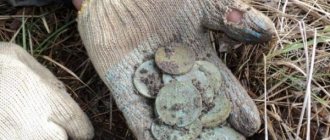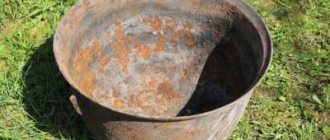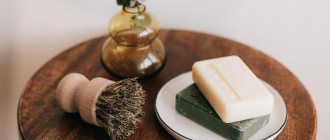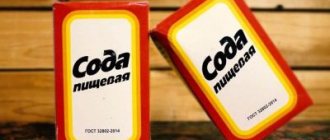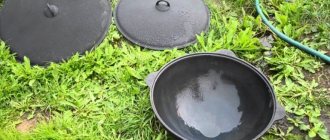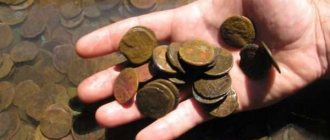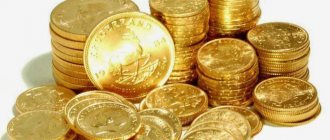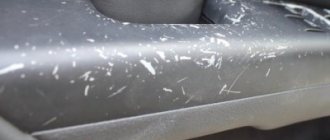Ancient and current coins are often covered with red, whitish, and green spots. Such defects have nothing to do with a noble patina, as they are the result of oxidation.
To remove traces of oxides and contamination, it is recommended to use the most effective recipes. Folk remedies or professional formulations can act as cleaners.
When carrying out restoration work, it is important to take into account the degree of corrosion and the material from which the coin is made.
Let’s look in more detail at how and how to clean coins, including rusty old ones, from rust and oxidation at home.
How can I remove it using folk remedies?
The appearance of rust and other oxides on coins is the result of contact of the products with:
- water,
- earth,
- fat and other substances.
Removing oxidation products using home remedies is not difficult if used correctly. Folk recipes use the most accessible and inexpensive means that are available in any home.
These include:
- soap,
- soda,
- cola,
- ammonia,
- kerosene,
- spoiled milk,
- vinegar,
- citric acid or juice,
- toothpaste.
Soap
There can be any type of solid detergent. Most often they use laundry or baby soap.
The method is considered gentle, effective and universal , as it is suitable for any coins. However, it only helps to cope with weak traces of oxidation.
Prepare a soap solution in a container by adding shaved soap (40 g) to heated water (60 ml). Place coins in the foaming liquid for 4-6 hours. After this, wipe off any remaining dirt with your fingers or a napkin and rinse.
Soap solution and soda
This method helps when a regular soap solution does not cope with the task of cleaning rust.
To prepare the product, take 30 g of finely grated soap and a teaspoon of soda. Mix the ingredients and add hot water to them to make a thick paste. The coin is immersed in a soap-soda mixture.
Soaking time depends on the degree of contamination . For some coins, a few hours are enough. For products that have undergone severe corrosion, it takes up to several days or even weeks.
If coins are kept in a soap-soda slurry for a long time, then periodically the composition is replaced with a fresh one, and the deposits that have formed are removed from the surface of the metal with a napkin.
How to clean with kerosene?
The product is one of the most effective and simple. However, during cleansing it is necessary to carefully monitor the process in order to recognize its completion in time.
For work, take a transparent glass or container made of chemically inert material . They put coins in it and fill it with kerosene. To mitigate the reaction, you can add a small amount of WD-40 lubricant.
The holding time depends on the depth of oxidation and can range from several minutes to 24 hours. The transparent walls of the dishes allow you to monitor the dissolution of oxides. As soon as the surface of the object is clean, it is taken out and wiped with a cloth.
How to remove with ammonia?
The ammonia product helps to easily achieve a positive result, and the cleaning process itself is simple and quick.
Coins covered with rust and oxides are placed in a container and filled with 10% ammonia. The exposure time in the reagent depends on the degree of contamination and can range from 10 seconds to an hour.
During soaking, the round timber is periodically turned over without removing it from the ammonia . When cleaning is completed, add clean water to the container to dilute the concentration. After this, the coins are taken out and washed with water. Experts do not recommend removing coins from concentrated ammonia.
If the metal is slightly oxidized, ammonia can be used in another way: apply the liquid to a cotton swab and wipe the surface of the product.
How to remove old rusty deposits with Coca-Cola?
Carbonated drinks containing phosphoric acid are often used to dissolve rust. A weak organic acid effectively removes oxides, converting them into easily removable salts.
The method is quite simple: money is placed in a container, filled with cola and left for 30-60 minutes . If necessary, the process is repeated.
You can speed up cleansing by very lightly heating the cola in a water bath. After the oxides have dissolved, the surface of the coins is wiped with a rag. Read more about cleaning objects and surfaces from rust using Coca-Cola here.
Simple methods for cleaning rust from modern coins
- For small rusty deposits, a toothbrush and toothpaste will help. Rub the coin on both sides well with a brush and paste, then rinse and dry.
- Throw coins into Coca-Cola - the phosphoric acid it contains will remove dirt and rust. To speed up the process, the container with coins can be placed in a warm place.
- It will help cleanse modern money and sour milk. It is necessary to keep the coins in it for 2-3 days.
- A mixture of vinegar and soda works well for removing dirt and rust. The prepared mixture is used for thorough cleaning, then the coin is washed and dried.
How to get rid of it using special compounds?
The chemical industry has developed many special products that help remove oxide from coins. Some of them are universal and suitable for any metal, others - only for a certain material.
Asidol-M
The universal product is available in the form of a paste or liquid . Asidol-M helps get rid of rust and dirt on precious metals, stainless steel, and non-ferrous metals. The composition includes surfactants, soft abrasives, and active additives.
Shake the bottle of liquid before use. Using a cloth or cotton swab, apply a small amount of product to the coin. Leave for a minute and rub the surface with a dry cloth until shiny.
The average price of a bottle (120 g) is 200 rubles.
Trilon-B
A white powdery product, the main component of which is the disodium salt of ethylenediaminetetraacetic acid.
Suitable for cleaning banknotes made of non-ferrous metals. When working with Trilon-B, be sure to wear rubber gloves .
Pour 200 ml of warm water into a plastic or glass container. Dissolve a teaspoon of powder in it. Using a brush or sponge, apply the solution to the surface of the coin.
The holding time depends on the degree of oxidation of the metal . After cleaning, the product is washed with water.
A jar containing 100 g of the drug costs an average of 200 rubles.
Modern Russia
Shine Coins brand paste product is designed to remove oxides from bimetallic and plated coins. In addition to inorganic acids, the formula contains nanodispersed abrasive, surfactant.
Before opening the jar, shake it, apply the paste to a cotton pad and distribute it over the surface of the product . After the metal is clean, the coin is thoroughly washed with water. A 150 ml jar can be bought for 300 rubles.
Abrasive tools
You can remove rust yourself using abrasive tools. Their use allows you to effectively clean the affected areas.
- Almost any metal tool can be used to remove rust.
- After the procedure, be sure to walk over the surface with sandpaper. It is important to remove all traces of scratches.
- A steel brush can effectively clean a metal surface.
- If you need to remove rust from a large object, you can use a grinding machine.
What can't be used and why?
To preserve the design on coins and protect the surface from scratches and other damage, you must remember about prohibited cleaning products and methods.
The following are taboo:
aggressive compounds - strong reagents can partially dissolve the metal and damage the image;- abrasives - they scratch the metal surface and smooth out the three-dimensional pattern;
- strong heating - heat treatment can cause deformation of an expensive product;
- prolonged soaking in any cleaning agent can deteriorate the appearance of the coin.
If a particular product raises doubts about its effectiveness and safety, it is recommended to refrain from using it. This is especially true for radical ultra-fast methods. They may harm the coin and reduce its numismatic or modern value.
Prevention measures
The above describes how to remove rust. It is definitely worth taking measures to help prevent its formation.
- Metal must be kept dry. If water comes into contact with the surface of the product for a long time and saturates it, then the formation of rust will not be long in coming. After metal comes into contact with water, it should always be thoroughly dried.
- For protection, a primer should be applied. For rough surfaces, putty primer is suitable. For a smooth finish, you can use aerosol primer.
- It is also worth applying a layer of paint to the item; it will effectively protect it from moisture.
https://h-sw-h.com/stroy-i-rem-svoimi-rukami/landscaping/chem-ubrat-rzhavchinu-s-metalla.html
Features of cleaning coins made of different materials
Despite the fact that there are universal means for removing oxides from the surface of coins, it is extremely useful to know the features of cleaning different types of metals .
Each material has its own subtleties and cleaning tricks:
- Gold Silver . For expensive metals, ammonia products and soap solution are suitable. The use of powdered detergents is not recommended. Despite their cleaning properties, they leave a cloudy film on the surface. Soft brushes are suitable for polishing precious metals.
- Copper. Red oxides are removed from copper coins with ammonia. Green or yellow plaque is easily removed with organic acids. It is advisable to cover copper with a patina, as it protects the active metal from oxidation.
- Bronze. To treat the surface, coins are dipped in hot vegetable oil for 5 minutes, washed with water and then with alcohol.
- Zinc. Cleaning such products is a labor-intensive process involving the use of 1% hydrochloric acid. When cleaning, it is important to monitor the condition of the metal every second; the coin is cleaned with a brush without removing the acid from the solution.
- Aluminum. It is not recommended to completely remove the gray oxide film on the surface of coins, as this worsens the aesthetics of the product. It is enough to make it thinner using soft products (soap, cola).
Coins that are made of two or more metals are cleaned especially carefully. For such products, it is recommended to choose universal safe reagents.
List of essentials
Before you start cleaning, you should find something to clean with. To do this, look for the following tools at home:
- Old toothbrush
- Tweezers,
- Toothpick,
- brush,
- And the coin cleaner itself.
Before choosing how to clean coins at home, determine the material from which your product is made. Some methods are not suitable for specific alloys. For example, when processing silver, you should not use abrasives, as they can scratch it. In general, the following are used to make coins:
- Iron,
- Copper,
- Aluminum,
- Zinc,
- Gold,
- Silver,
- Platinum,
- Nickel,
- Chromium,
- Tin,
- Zinc,
- Manganese.
You can also find an alloy of several different metals. Let's look at the most effective methods by which you can clean coins at home.
Additional Tips
Using home and professional products from the store allows you to quickly achieve positive results. To ensure that the cleansing process goes smoothly, it is useful to listen to additional recommendations:
If the rusty layer is old, and the coin is of great antique value, it is advisable to entrust its cleaning to a specialist. The workshops use professional ultrasonic equipment, which allows you to delicately remove the oxide.- Regardless of the chosen product, after cleaning, remove traces of plaque from the metal surface, rinse with clean water and dry thoroughly with a paper or cloth napkin.
- For drying, it is allowed to use a thermostat or a drying cabinet in which the temperature is set at 50-80 degrees.
- To protect against oxidation after cleaning, coins can be preserved in paraffin or synthetic resins. A 5% solution of polybutyl methacrylate in acetone, toluene or xylene or a solution of polyvinyl butyral in alcohol is also suitable for processing.
- Gold and silver coins should be stored separately from other items. This will reduce the rate of their contamination and oxidation.
Lemon
You can also remove rust from skates using lemon. You need to clean it and grind the resulting pulp. Then the juice is filtered through a fine strainer or piece of gauze. Instead of gauze, you can use any loose fabric.
Lemon juice is mixed with baking soda in equal parts. The resulting gruel is carefully rubbed into the damaged areas. The most convenient way to do this is with a rag. Movements should be smooth, but with some pressure. The procedure continues until the rust is completely cleared. Next, the remaining slurry is removed from the runners, the blades are thoroughly washed with water and dried.
